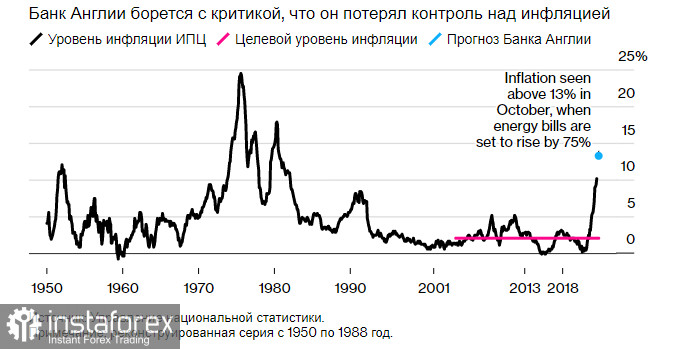The pound sterling has begun to lose ground against the US dollar following the release of hotter than expected UK inflation data. Prices in the UK jumped to the highest level in 40 years, weighing down on consumers and increasing pressure on the economy by the UK government and the Bank of England.
According to today's report by the UK Office for National Statistics, the CPI rose by 10.1% in July from 9.4% in June, surpassing the expected 9.8% increase.
Rising prices of foodstuffs, particularly bread, cereals, milk products, meat, and vegetables, have driven the index upwards. This indicates that fuel prices are not the main cause of inflation, despite statements by UK officials. Other categories of goods which significantly advanced in July were pet food, toilet paper, toothbrushes, and deodorants.

Soaring inflation is very likely to exacerbate the ongoing cost-of-living crisis, which has been plaguing the UK since March 2022. Despite stronger wage growth, average earnings still cannot catch up to the rising prices of food and services. The Bank of England expects inflation to surpass 13% in October, when the UK will lift price caps on energy. Andrew Bailey, the governor of the Bank of England, stated he sees the UK economy enter a recession by the end of 2022. Now, investors are pricing in a 50 bps hike in September.
As noted above, rising inflation is putting pressure on real wages, even when taking the observed increase in average earnings into account. The situation is likely to deteriorate further following the energy price upsurge in October. As a result, many economists see increasingly poor prospects for the UK. The risk of a recession is higher now than it was previously. The BoE expects the economic downturn to last until early 2024.
Energy prices have increased by 22.6% year-over-year, slightly easing from the previous months due to falling crude oil prices. Output prices rose by 1.6% month-on-month and by 17.1% from a year earlier, the largest annual gain since 1977. The Retail Prices Index increased by 12.3% from a year ago, up from 11.9% the month before.
According to yesterday's data release, real wages in the UK fell by 3% in three months though June. Employment decreased by 160,000 jobs in the second quarter of 2022, a 46% decline compared to the three months through May, while job vacancies fell for the first time since August 2020. This indicates that the cost of living crisis is a very real issue for both households and businesses.Despite the pound sterling moving up yesterday and hitting new weekly highs, GBP/USD bulls would have to keep the pair above 1.2100. If the pair remains above this level, it could then rise towards 1.2140. A breakout above this level would open the way towards 1.2180 and 1.2225 further ahead, as well as 1.2250. If GBP/USD breaks below 1.2100, the situation will drastically change unless bullish traders step in. In this scenario, bears could nullify yesterday's upward movement of GBP/USD and push the pair down towards 1.2070 and 1.2040.
The key economic event for EUR/USD is the release of eurozone GDP data. Until then, bulls could push the pair upwards if EUR/USD stays above 1.0160. If it settles at 1.0190, it could then return to 1.0220, which would open the way towards 1.0250 and 1.3010. However, if EUR slides down below 1.0160 and fails to hold on to 1.0130, it would likely then drop towards 1.0100, as bearish traders would try to overturn the pair's upward momentum caused by US inflation data. A breakout below 1.0100 would open the way towards 1.0070 and 1.0040.
 English
English 
 Русский
Русский Bahasa Indonesia
Bahasa Indonesia Bahasa Malay
Bahasa Malay ไทย
ไทย Español
Español Deutsch
Deutsch Български
Български Français
Français Tiếng Việt
Tiếng Việt 中文
中文 বাংলা
বাংলা हिन्दी
हिन्दी Čeština
Čeština Українська
Українська Română
Română

